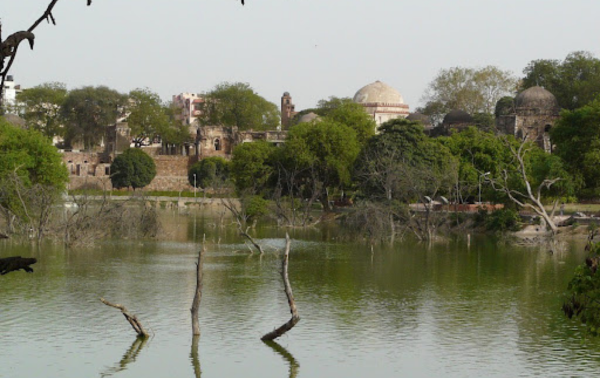Delhi, a city steeped in history, whispers tales not just through its monuments but also through its ingenious water structures. These structures, crafted from stone, stand as keepers of history, each bearing witness to the ingenuity and foresight of those who came before.
From the majestic baolis to the intricate stepwells, Delhi’s traditional water systems paint a vivid picture of a city deeply intertwined with its water heritage. These weren’t mere fountains; they were the lifeblood of a bustling metropolis, each with its own story.

Delhi’s urban waterworks date back to the early thirteenth century during the reign of the Delhi Sultanate. The hauz (water tank), baoli (stepwell), and bund (embankment) were not mere structures but lifelines, offering respite in times of scarcity. These ancient systems were meticulously designed to capture rainwater, recharge groundwater, and sustain communities through the arid seasons. Take the Hauz Khas Complex, a 13th-century which translates to “Royal Tank”, a testament to its importance. Envision life in a time before piped water. This rectangular tank, lined with impervious plaster, collected monsoon rains and spring water, quenching the thirst of residents and irrigating nearby gardens. Stone steps led down to the water’s edge, bustling with activity: women washing clothes, children splashing playfully, and men filling clay pots for their homes. Today, the Hauz Khas, surrounded by upscale shops and trendy cafes, is a stark contrast to its past. However, its restored state and integration into the modern urban landscape serve as a constant reminder of the city’s water heritage.
One such marvel is Gandhak ki Baoli, built in 1230 AD by Shams ud-Din Iltutmish. This stepwell, nestled in Mehrauli, served as a sanctuary during water shortages and a social hub for gatherings. Its architectural simplicity belies its crucial role in providing water for bathing and sustenance to the locals.

Travel a few miles south to Agrasen ki Baoli, a stepwell unlike any other. Imagine descending 103 narrow steps, sunlight filtering through intricate carvings overhead, to reach the cool, refreshing water. This 16th-century marvel wasn’t just a well; it was a social hub. Merchants met to strike deals, housewives exchanged gossip, and weary travelers rested their tired feet. Its architectural brilliance, with its geometric design and octagonal well shaft, reflected the Mughal era’s artistic prowess. Today, Agrasen ki Baoli, meticulously restored, is a popular tourist spot. It’s a bridge between the past and present, reminding us of the ingenuity of our ancestors and the importance of social spaces fostered by water.

However, not all water structures have fared so well. The Rajon ki Baoli, another architectural gem, lies in a state of disrepair. Its once-gleaming plaster is cracked, its steps overgrown with weeds.exclamation This neglect reflects a larger issue – the struggle to balance development with heritage conservation. While Delhi’s modern water needs are met through a complex network of pipes and reservoirs, these historical structures serve a different purpose now. They are windows into our past, testaments to the city’s evolution. As Delhi grapples with a modern water crisis, these ancient reservoirs offer valuable lessons in sustainable water management. Reviving these structures is not just about preserving history but securing Delhi’s future water security.
The future of Delhi’s water structures lies in responsible restoration and adaptive reuse. Imagine Hauz Khas not just as a backdrop for cafes, but hosting cultural events that celebrate water. Picture Agrasen ki Baoli as a community space, where residents gather for traditional storytelling sessions under the moonlight. The possibilities are endless.
The dilapidated state of these structures serves as a stark reminder of the need for conservation efforts. Organizations like the Archaeological Survey of India are working towards restoring these gems to their former glory. By learning from these structures, Delhi can embrace sustainable water management practices. The baolis, with their focus on rainwater harvesting and groundwater recharge, offer valuable lessons in a time of depleting resources. The revival of ancient water structures presents a beacon of hope amidst Delhi’s water woes. By harnessing traditional wisdom and blending it with modern technology, Delhi can pave a sustainable path towards water security. Initiatives like rainwater harvesting and restoration projects breathe new life into these historical treasures.
The story of Delhi’s water structures isn’t just about bricks and mortar. It’s a story of human ingenuity, social interaction, and a respect for the life-giving resource–water. As we move forward, let us not just conserve these structures, but also imbibe the values they represent: resourcefulness, community, and a deep connection to our roots. These structures teach us resilience, foresight, and the value of harmonizing with nature. They remind us that sustainable solutions lie in embracing our heritage while adapting to present needs. By honoring our past, we can forge a more sustainable future for generations to come.
By – Sulagna Maitra
Sources:
https://www.sahapedia.org/traditional-water-systems-of-delhihttps://circularwaterstories.org/analysis/ancient-waterworks/https://www.cntraveller.in/story/gandhak-ki-baoli-delhi-the-story-behind-stepwell-that-fought-a-water-crisis/https://timesofindia.indiatimes.com/city/delhi/old-water-harvesting-structures-still-high-tech/articleshow/9710673.cmshttps://www.bbc.com/future/article/20211012-the-ancient-stepwells-helping-to-curb-indias-water-crisis
